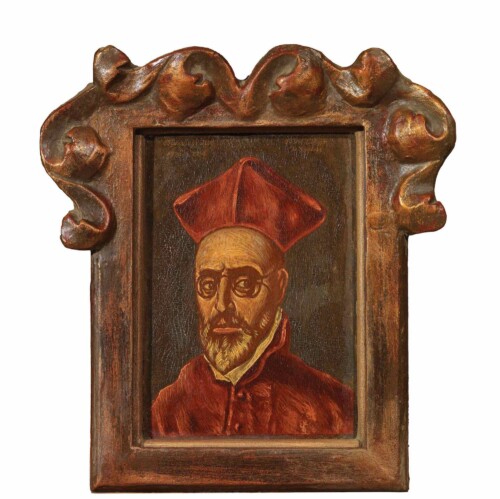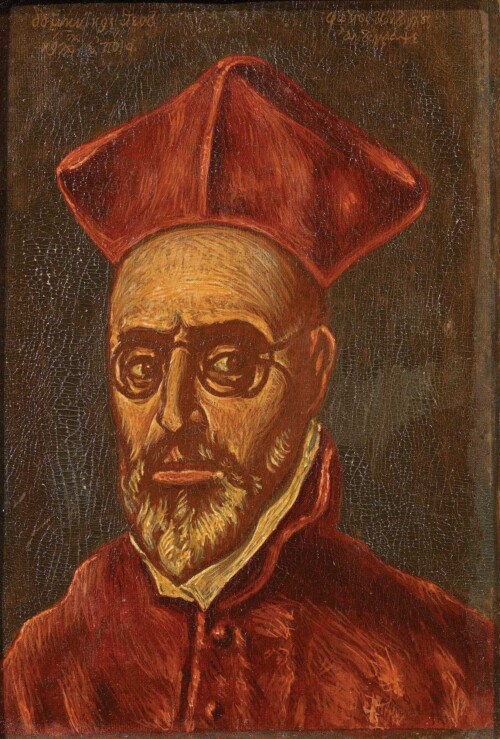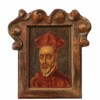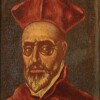| 05 |
Greek, 1895-1965
Portrait of Cardinal Fernando Nino de Guevara
oil on card
signed and inscribed upper right φώτιος κόντογλου ’αντέγραψε
inscribed upper left δομήνικος θεοτοκόπουλος
circa 1922-1930
18 x 12 cm
PROVENANCE
This work was acquired directly from the artist by the father of the present owner.
private collection, Athens
NOTE
The work is a detail of the work Portrait of Cardinal Fernando Nino de Guevara (circa 1598) by Domenikos Theotokopoulos known as El Greco.
The work is in the frame presented originally by the artist.
| sold for 5,303.25 € |
Fotis Kontoglou was born in Aivali, Asia Minor in 1895. A year later he lost his father, Nikolaos Apostolellis and the upbringing of him and his siblings was undertaken by his maternal uncle Stefanos Kontoglou, the Abbot of Agia Paraskevi monastery. Perhaps this is the reason he used his maternal surname, as a tribute to his uncle.
The young Kontoglou spends his elementary and high school years in Aivali. Among his closest friends during this period are the future writer, Stratis Doukas and the future ceramic artist, Panos Valsamakis. In 1913 he moved to Athens and enrolled at the School of Fine Arts, only to abandon his studies two years later to travel to major European cities and finally settle down in Paris (However, he finalised his studies in 1933 when he needed the degree to teach at the Athens College).
During his time in Paris, he did not follow any formal education but instead he worked for magazines such as ‘Illustration’ producing ink illustration drawings. Of great importance during this period is his friendship with painter Spyros Papaloukas. While in Paris he writes his masterpiece ‘Pedro Cazas’ which will be first published on his return to Aivali by his childhood friend, the writer Stratis Doukas and would be highly praised by Nikos Kazantzakis, Elias Venezis and Stratis Myrivilis.
In 1919 he returned to his birthplace Aivali and accepted a position as a high school teacher of French and art studies. After the Catastrophe of Smyrna, he moves first as a refugee to Mytilene and then to Athens with the help of authors Vasos Daskalakis and Elli Alexiou where he works as an illustrator for the Encyclopaedic Dictionary Eleftheroudakis.
During this period, he visits Mount Athos where he first comes in contact with Byzantine art, especially painting. The ink drawings he produced during his visit are exhibited first in Mytilene together with Constantinos Maleas and then at the Lyceum Club of Greek Women in Athens (1923).
In 1925 he published the art magazine 'Φιλική Εταιρεία’ together with Dimitris Pikionis and Giannis Kefallinos among others and a year later illustrated the biography of Pavlos Melas who was among the first who organised and participated in the Greek Struggle for Macedonia.
From 1931 he works as an icon conservator at the Byzantine and Christian Museum in Athens. In the years to follow he worked as a conservator at the Corfu Museum, the Coptic Museum in Cairo, Egypt but most importantly from 1936 onwards at Mystras, Peloponnese, where he restored the fresco icons of the church of the Peribleptos Monastery.
In 1932 he decorated his home with fresco decoration with the help of his students Yiannis Tsarouchis and Nikos Engonopoulos. With this work he revived the ‘forgotten' century-old tradition of fresco painting; the fresco is now in the collection of the National Gallery.
Kontoglou was an essential figure of 20th-century Greek art and one of the most important of a group of artists, who are collectively referred to as the ‘Thirties Generation'. They are attributed with having created a renaissance of Greek art in the Interwar years, combining the teachings of the European avant-garde while referencing their Greek heritage. His painting combined elements of Greek art from the classical antiquity, Byzantine art, the work of Domenikos Theotokopoulos and the work of Theofilos Hadjimichael among others. His writings are equally essential and revolutionised Greek literature from the 1920s onwards.
His work is found in many public and private collections, notably: the National Gallery of Greece, the Athens Municipality Gallery, the Rhodes Municipality Gallery, the Leventis Gallery, the Teloglion Fine Arts Foundation, the National Bank of Greece Cultural Foundation.



